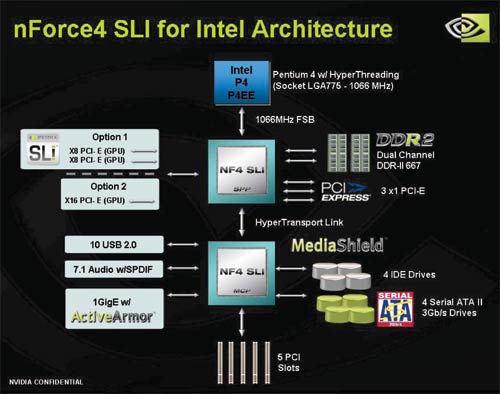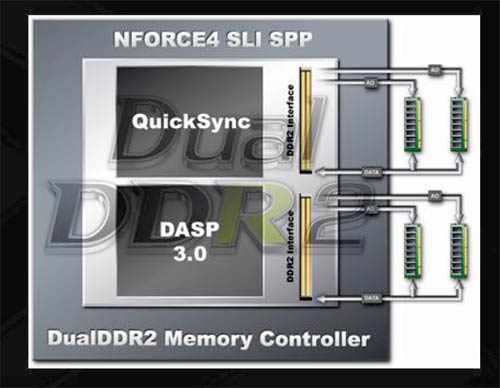Dual Core Intel Platform Shootout - NVIDIA nForce4 vs. Intel 955X
by Anand Lal Shimpi on April 14, 2005 1:01 PM EST- Posted in
- CPUs
NVIDIA's nForce4 SLI Intel Edition Chipset
As we've indicated in the past, NVIDIA's first Intel chipset is very similar to their nForce4 AMD chipset, with a couple of exceptions. For starters, the Intel Edition chipset is made up of two chips, compared to the AMD chipset's one. The reasoning is simple: with AMD's architecture, NVIDIA needn't include a memory controller in their chipset, which cuts down on overall die size quite a bit. With the Intel Edition, we see the first new memory controller that NVIDIA has introduced since nForce2.

Remember DASP? NVIDIA's Dynamic Adaptive Speculative Pre-Processor is back in nForce4 Intel Edition, but this time around, the competition is much stronger. DASP is a hardware pre-fetch engine that resides within the memory controller and attempts to pre-fetch data into a small amount of cache on the chipset, which NVIDIA's algorithms determine will be used by the CPU in the future. Intel has a similar technology in their 955X chipset, although it's not something they have branded or marketed. Depending on how aggressive NVIDIA's DASP is, it could make good use of the extra memory bandwidth offered by its dual channel DDR2-533/667 memory bus.

NVIDIA also boasts a dedicated address bus per DIMM slot with the nForce4; however, this seems to be a feature also supported by Intel, so there isn't much advantage over the competition here.
In their final memory controller optimization, NVIDIA's QuickSync claims to be able to reduce memory latency when operating in multiple clock domains (e.g. 800MHz FSB, but 533MHz memory bus). Later in this article, we'll find out exactly how aggressive NVIDIA's memory controller truly is.
The nForce4 SLI Intel Edition chipset supports both 800 and 1066MHz FSBs, just like the 955X - however, NVIDIA also indicated that if Intel were to increase the FSB frequency, they would be ready.
Unlike the 955X, NVIDIA only supports 3 PCI Express x1 slots. However, NVIDIA does offer two PATA channels, compared to Intel's single PATA channel. NVIDIA also offers more USB 2.0 ports (10 vs 8). NVIDIA does not support Intel's HD Audio spec, so you're stuck with AC'97 on the nForce4 SLI.










96 Comments
View All Comments
Spajky - Saturday, May 7, 2005 - link
Some comments:Memory Performance:http://www.anandtech.com/cpuchipsets/showdoc.aspx?...
Here should be included also WinRAR´s built_in benchmark & hardware test" in KB/s,
since it can be treated as a real life memory subsystem benchmark (& NOT a Data
Compression Bench! for CPU for example)
WinRAR´s built_in benchmark & hardware test" :
some tests/benchmarks & explanation HOW IT WORKS, here:
http://freeweb.siol.net/jerman55/HP/benchMem.htm
Pontius - Tuesday, April 19, 2005 - link
Didn't realize there was no hardware XOR. Thanks for clearing that up elecrzy.xsilver, RAID 5 is a big deal and is a long way ahead of RAIDs 0 and 1. Most motherboards offer RAIDs 0 and 1, but only high end expensive ones offer onboard RAID 5. Without it, you need a SCSI or SATA RAID card which will run you a couple hundred bucks. To have that on a desktop board is a major deal. But again, since it's done by the CPU without XOR hardware, it's not that big a deal I guess.
elecrzy - Monday, April 18, 2005 - link
sorry i meant #88elecrzy - Monday, April 18, 2005 - link
#89: the chipset doesn't offer its own XOR processor for RAID 5 so it has to rely on the cpu to do the calcs. this basically means you lose alot of performance(high cpu usage) when compared to hardware raid cards.mickyb - Monday, April 18, 2005 - link
RAID 5 and 10 is indeed a big deal for a built in chipset. It is a little outside the scope for a desktop, but cool none the less. I would have to also give a win to nVidia for providing GbE on the chip. I guess Intel would rather people use their GbE separate chip.Zebo - Sunday, April 17, 2005 - link
Zebo - Sunday, April 17, 2005 - link
Intel has a nice chipset, as usual. Nvidia, as usual, clueless about audio desires which would add insignifigant price to chipset at great gains to most consumers. I don't really see the Nvidia recomendation at all unless you NEED, Sli. Intel has more feature, way better audio, the NCQ differences are really none and it's cheaper.xsilver - Sunday, April 17, 2005 - link
#88 -- I think it is old news... I think the older 9xx chipsets offered raid 0,1 for free so offering raid 5 on the newer chip may not be so crash hot??and questar, talking to you is a bit like talking to a brick wall....
a lot of us here already explained that we are arguing about performance NOT volume... what you specify as "qualifications" is due to the sheer volume intel ships.... most people are aware that AMD only has 15% of the market.
If IBM,HP,Dell dont want to "qualify" AMD systems, its their loss, not ours
but no matter how you argue it, AMD has the performance advantage on everything, high end, middle and low end right now and only the laptop pentium M is the performance advantage for intel right now
Pontius - Sunday, April 17, 2005 - link
Am I the only one that noticed that the Intel chipset supports on board RAID 5?!?! That's amazing! No need to buy expensive raid cards anymore. I'm surprised they didn't pay any attention to that in the article.stevty2889 - Saturday, April 16, 2005 - link
My case meets the standards for running prescotts..my 3.2 ES and my 2.8@3.5ghz ran perfectly fine in the same case, the 3.2ES also on the same motherboard, with all the same components, and neither my 2.8 or 3.2ES had the heat issues of my 3.4ghz chip. Not all of them run too hot, but some seem to do so no matter what cooling you throw at them. The 3.4 is still running warmer with water cooling, than my 3.2 ES(which I got from the chip loaner program) is with air.